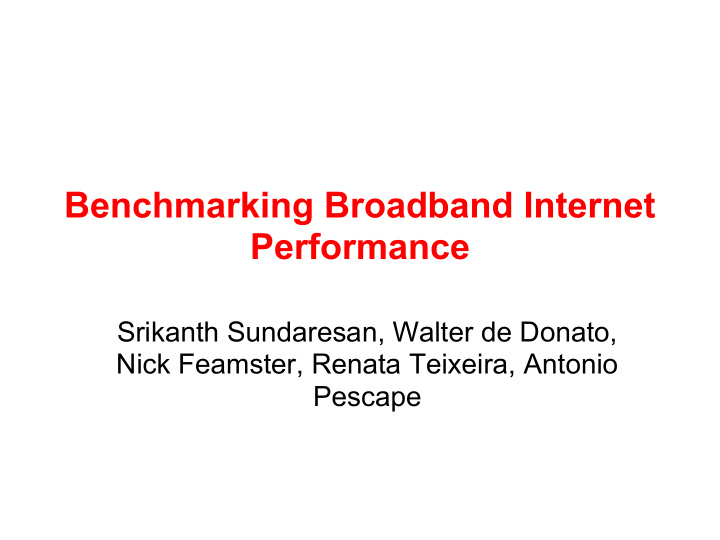



Benchmarking Broadband Internet Performance Srikanth Sundaresan, Walter de Donato, Nick Feamster, Renata Teixeira, Antonio Pescape
What is the Performance of Network Access Links?
Previous Performance Studies Study from outside Dischinger et al. (IMC 2008), Netalyzr (IMC 2010) Not continuous, not many per user, no view into home Study from inside Grenouille project Hard to account for device diversity Hard to account for home network
The BISMark Project Periodic measurements to last mile and end-to-end Measure directly at the gateway device Adjust for confounding factors
BISMark Deploy programmable gateways in homes NoxBox deployment: about 35 around Atlanta SamKnows deployment: about 10000 around the US Netgear NoxBox
Gateway Vantage Point: Advantages Observes all traffic passing through network Isolate individual factors affecting network performance Wireless Cross traffic Load on measurement host End-to-end path Configuration
Current Deployment 16 boxes deployed 10 in ATT, 4 in Comcast, 2 ClearWire Most of the deployments within Atlanta All measurements done to server at Georgia Tech
Active Measurements
Results Throughput Different throughput techniques capture different aspects of throughput There is high variation across users with same technique Latency Latencies vary within the same ISP Last-mile latencies are significant Modem buffers are too large Modifying data transfer using using traffic shaping might mitigate the problem in the short term
Different Techniques, Different Aspects of Throughput Single threaded is what users see on a single download Web browsing is mostly multi-threaded
Different Users, Different Performance Same service plan & ISP, different loss profile User 1 sees much more loss, but also much lower latency User 2 has interleaving turned on
Traffic Shaping Differs Across Users Different burst magnitudes Different lengths of time Download shaping
Traffic Shaping under Upload How do we account for such variance? Implications for speed test results?
Results Throughput Different throughput techniques capture different aspects of throughput Depending on how throughput measurements are conducted, they may vary considerably across users Latency Latencies vary within the same ISP Last-mile latencies are significant Modem buffers are too large Modifying data transfer using using traffic shaping might mitigate the problem in the short term
Last mile latency varies across users RTT RTT (ms) (ms) Baselines Different for 2 ATT customers. Same service plan, within a few blocks of each other. Interleaving modes are different.
Last-Mile Latencies are Significant All but 2ms comes from last mile Last mile End-to-end latency latency High correlation (0.95) with end-to-end latency
Effect of Access Link Technology Baseline latency dependent on access technology ADSL last mile – 8 to 25ms, Comcast ~10ms WiMAX – ~ 75ms! RTT RTT (ms) (ms) Comcast Clear
Buffers are Too Large Buffering in modems can be as high as ten seconds! Can be empirically modeled with token-bucket filter Also exist elsewhere in the stack Latency profile while saturating upstream link
Traffic Shaping Affects Latency, Too After different periods of time, latency and loss profiles change dramatically
… and in different ways Possible cause: dynamic buffer sizing
Keeping Latency Under Control Intermittent or shaped traffic can achieve same levels of throughput, without incurring high latency
Other fixes for Latency Under load Shaping traffic comes at the cost of sacrificing throughput Is it possible to fix latency without affecting throughput? Smaller buffers might affect long flows Some sort of Active Queue Management? RED, Fair queueing
Takeaway Lessons One measurement does not fit all Different measurements yield different results Different ISPs have different shaping behaviors One ISP does not fit all There is no “best” ISP for all users Different users may prefer different ISPs There is a need for a “nutrition label” Home network equipment can significantly affect performance
Thanks! Comments? srikanth@gatech.edu
Recommend
More recommend